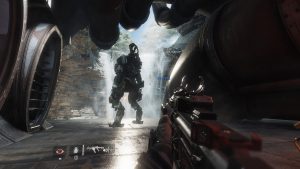 Yes, it has been too long since I last posted, but I have a perfectly valid reason for that: much of my free time has been spent playing, and finishing, games. At the beginning of the year, I committed myself to playing through a short game every weekend and, for the most part, I’ve stuck to this plan. There was one rather bad game I couldn’t bring myself to power through (the brutal puzzle adventure htoL#NiQ: The Firefly Diary), but the rest of these short games have been decent to great.
Yes, it has been too long since I last posted, but I have a perfectly valid reason for that: much of my free time has been spent playing, and finishing, games. At the beginning of the year, I committed myself to playing through a short game every weekend and, for the most part, I’ve stuck to this plan. There was one rather bad game I couldn’t bring myself to power through (the brutal puzzle adventure htoL#NiQ: The Firefly Diary), but the rest of these short games have been decent to great.
Tag: strategy
Thanks to the long development time of Mary Sue’s Character Casino, I didn’t beat as many games as I usually do. Meanwhile, my backlog has grown in leaps and bounds. As part of this blog’s revival, the backlog updates will return; expect the 2022 edition in about a week. For now, though, it’s time to look back on my favorite games in 2021.
As usual, every game here is one I’ve beaten (or played extensively, in the case of “endless” titles) during the past year, regardless of release date. For each game in the top ten, the title, developer/author, platform(s) I played it on, and the release date for said platform in my region has been included, along with a little bit about why I found this game so memorable.
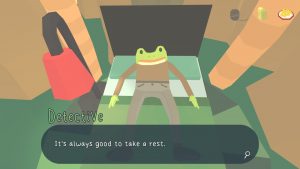 In late February, I pulled a muscle in my leg, and the initial pain was so bad that I’m still recovering. I haven’t gone to a doctor, but progress has been good, and I hope it won’t be much longer until it’s all better. It’s been somewhat frustrating spending most of my days icing my leg on the couch while there’s stuff that needs to be done and various rooms in our house gather dust, but at least I’ve been able to pass the time with some games.
In late February, I pulled a muscle in my leg, and the initial pain was so bad that I’m still recovering. I haven’t gone to a doctor, but progress has been good, and I hope it won’t be much longer until it’s all better. It’s been somewhat frustrating spending most of my days icing my leg on the couch while there’s stuff that needs to be done and various rooms in our house gather dust, but at least I’ve been able to pass the time with some games.
Quick note: this is my entry for this year’s Review a Great Game Day, a writing jam organized by retro gaming site 1 More Castle. Enjoy!
Out of all the games Shigeru Miyamoto has created, Pikmin is far and away my favorite. I’ve put countless hours into Shiggy’s creations over the decades, from Donkey Kong to Wii Fit, but none has captivated me quite so much as his intimate tale of a diminutive spaceman and the even tinier creatures who aid him during a crisis. It is visually and aurally charming, not to mention a brilliantly designed example of how to do real-time strategy on a console, but it’s also much, much more.
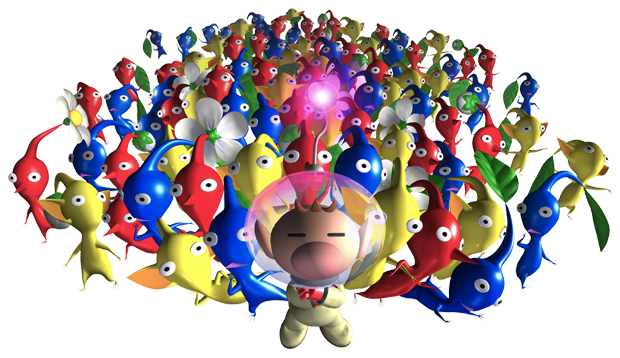
Pikmin is something which is, even now, extremely rare amongst big-budget titles: a narrative game about a normal grown adult. The main character, Captain Olimar, is on an alien planet not because he’s been sent there to fight a war, nor is he chasing adventure or purpose. He’s there by accident. He’s a run-of-the-mill businessman, in the middle of traveling, who crash-lands in unfamiliar territory and spends the rest of the game calmly trying to repair his ride and get home to his worried wife and kid. There are no princesses or kingdoms to save; the only thing which needs rescuing is himself. Despite the fantastical universe he resides in, he’s as familiar as most any commuter you may see on the train in the morning. In this way, Pikmin is about the trials and mundanities of adulthood as much as many other games are examinations of adolescence. It’s shockingly refreshing, and Olimar has since become one of those rare game characters with whom I can truly identify.
Actually, I have to take something back—part of that “fantastical universe” of Olimar’s is almost as ordinary as he himself is, but in a different way. While the planet Olimar lands on is new and interesting to him, its identity soon becomes apparent to the player. As evidenced by the litter that Olimar encounters during his crisis, this strange new world is our own. Sure, the flowers are giant numbered pellets surrounded by petals, the creatures include two-legged speckled bugs and bird-beaked burrowing snakes, and the Pikmin themselves are plant/animal hybrids that could exist nowhere else but a Nintendo game, but there’s no mistaking it. Olimar is on Earth, and he is the size of an insect upon it.
The presence of the Pikmin and other weird living things, combined with the familiarity of Olimar’s situation and the random man-made flotsam, is perhaps meant to make us think about the nature we too often take for granted and our relationship to it. Study real-life plants and animals closely, and you’ll notice a wondrous, vibrant world, perhaps one similar to that which Olimar sees. Even at the current rate of extinction, new species are still being discovered; with that in mind, the birds and bugs of Pikmin don’t seem all that farfetched. The primary-colored Pikmin are clearly inspired by ants, insects which famously work together in groups and come in a wide variety of types. Scenes of them flocking around any given object are entertaining in the same way as watching ants carry a piece of food that’s much larger than they are.
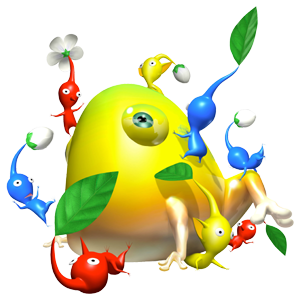 This mix of the unusual and the ordinary naturally extends to the gameplay. As I said earlier, Pikmin is a real-time strategy game. The RTS genre is traditionally relegated to the PC, due to the need for precise controls, such as with a mouse, to organize and command units. Pikmin takes the RTS concept and simplifies things, with just three types of units (red, yellow, and blue Pikmin) and a total limit of one hundred individuals that can be controlled in the field at any time. The defense stats of these units is indicated, Super Mario Bros.-style, by physical appearance, and the best of these can be most easily cultivated by letting them “grow” in the ground for a longer period of time. In any other situation, this would not be a problem, but Olimar has only thirty days to find the same number of parts for his spaceship before his life-support system dies. Thus, time is Olimar’s largest, most ominous opponent, moreso than the massive creatures that attempt to eat the Pikmin along the way. Success in this game is determined by your command of the Pikmin, and how well they can fight off threats and navigate territory both while searching for and carrying back Olimar’s precious parts. Pikmin can be challenging at times, filled with all manner of clever obstacles and terrain, but it is also quite manageable, with a perfectly-tuned learning curve. It helps that the Wii’s “New Play Control!” port is a dream to play with its remote and nunchuck setup (unfortunately, there is no GameCube controller support in this release, so I could not compare the original control scheme to the new one).
This mix of the unusual and the ordinary naturally extends to the gameplay. As I said earlier, Pikmin is a real-time strategy game. The RTS genre is traditionally relegated to the PC, due to the need for precise controls, such as with a mouse, to organize and command units. Pikmin takes the RTS concept and simplifies things, with just three types of units (red, yellow, and blue Pikmin) and a total limit of one hundred individuals that can be controlled in the field at any time. The defense stats of these units is indicated, Super Mario Bros.-style, by physical appearance, and the best of these can be most easily cultivated by letting them “grow” in the ground for a longer period of time. In any other situation, this would not be a problem, but Olimar has only thirty days to find the same number of parts for his spaceship before his life-support system dies. Thus, time is Olimar’s largest, most ominous opponent, moreso than the massive creatures that attempt to eat the Pikmin along the way. Success in this game is determined by your command of the Pikmin, and how well they can fight off threats and navigate territory both while searching for and carrying back Olimar’s precious parts. Pikmin can be challenging at times, filled with all manner of clever obstacles and terrain, but it is also quite manageable, with a perfectly-tuned learning curve. It helps that the Wii’s “New Play Control!” port is a dream to play with its remote and nunchuck setup (unfortunately, there is no GameCube controller support in this release, so I could not compare the original control scheme to the new one).
The understated soundtrack is standard-quality Nintendo fare, but as for the graphics, they are Pikmin‘s most prominent weakness, as, despite their novel designs, they haven’t aged as gracefully as the rest of the game. Pikmin was originally released in 2001 and it shows, thanks to now-dated texturing and lighting, and simplistic character models. However, please don’t let this put you off on playing this masterpiece. It is one of the greatest and most unique video games of its kind, and also one of the best Nintendo has ever made. It is a surprisingly deceptive game, in a good way: approachable and wholesome enough for kids, but with a story and protagonist which are more relatable to adults. It speaks to its audience about nature and its relationship with humanity, without passing judgment on anyone or anything, leaving the player to reach their own conclusions about the world and its inhabitants. Most importantly, it is mature, in the truest sense of the word, than most other games which claim that adjective for themselves.
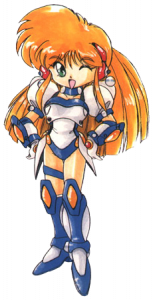 Remember that huge stack of game soundtracks I bought awhile ago? I’m still working my way through them. Have managed to listen to most of them, but one I haven’t touched at all is Front Mission 5 ~Scars of the War~ Original Soundtrack. A big part of this is because, as I said before, I haven’t played the actual game. Although this sort of thing hasn’t stopped me before, this is Front Mission, and therefore, special in my eyes.
Remember that huge stack of game soundtracks I bought awhile ago? I’m still working my way through them. Have managed to listen to most of them, but one I haven’t touched at all is Front Mission 5 ~Scars of the War~ Original Soundtrack. A big part of this is because, as I said before, I haven’t played the actual game. Although this sort of thing hasn’t stopped me before, this is Front Mission, and therefore, special in my eyes.
Front Mission 5 was, apparently, briefly considered for an official stateside release. However, this never panned out, and thus, fans took it upon themselves to do what very few (if any) had done before: an amateur translation of a PlayStation 2 game. Thus was born the Front Mission 5 Translation Project, which has since become the Front Mission Series Translation Project, as they are now working on patches for Front Mission 2 and Front Mission Alternative.
The group completed the beta translation patch of Front Mission 5 in December of last year, so all I would need to do is to hunt down a copy of the game and the necessary PS2 modding tools to get it to run. However, this brings me to the one criticism I have of the project. If the group’s goal is to draw Square Enix’s attention to English-speaking Front Mission 5 fans, then why make it so the patch works only on the non-Ultimate Hits verion of the game, which has long been out of print? I think a spike in sales of new copies of FM5, rather than secondhand ones, would push Square to consider an official release even more. For historical evidence, I point to Capcom, who localized the DS port of Gyakuten Saiban in North America (as Phoenix Wright: Ace Attorney) after noticing all the sales of the bilingual game that were coming from outside of Japan. Anyway, I know the fan translation team is well aware of this issue, and I hope they make an Ultimate Hits version of the FM5 patch a priority for future releases.
With FM5 on my mind lately, I got to thinking about what other Japanese games never made it over here that I would like to see complete translations of. There are some games that are “import friendly” in that you don’t have to know a lot of Japanese—if any—to be able to enjoy them, so those aren’t a problem. There are also those like Tales of Graces, Front Mission 2089: Border of Madness, and Game Center CX: Arino’s Challenge 2 that are still recent enough to have a chance of localization, slim though they may be. What’s left are the text-heavy titles which are on dead systems and have small cult followings, if they’re lucky. What’s left, in other words, are games like those on my wishlist.
Ys V: Lost Kefin, Kingdom of Sand, Super Famicom – I’m cheating a little bit here with a couple of them, including this first one. You see, a fan translation of Ys V was started several years ago, but the patch is currently incomplete. This leaves Ys V as the only main-series Ys storyline whose translation has never been made available. Rather frustrating if you’re interested in the Ys canon and don’t read Japanese, but even after all these years, the patching project is not dead, so there’s still hope.
Galaxy Fraulein Yuna and Galaxy Fraulein Yuna 2, PC Engine – And now for something completely different: visual novels! My initial exposure to Galaxy Fraulein Yuna came in the form of the first OVA series; later, I saw the much more coherent second series, Galaxy Fraulein Yuna Returns. Each storyline follows the adventures of teenage Yuna Kagurazaka, who is the savior of the universe, a popular celebrity, and a regular girl all at the same time. It’s a pretty wacky series, with some amazingly good character designs, all courtesy of mecha designer and Gundam Girl artist Mika Akitaka.
Some years ago, I learned that these anime were based on a “digital comic” game series, which gave me a better perspective on the character-stuffed OVAs. However, aside from the Sega Saturn’s Galaxy Fraulein Yuna 3 these games have never been translated into English, by anyone. The Yuna games have shown up on several systems, but the first two in the series are on the PC Engine, thus, my wishlist request. A PSP collection of the first two Yuna games as well as a related title, Galaxy Policewoman Sapphire, was published only a couple of years ago, so it seems there’s still interest in these oldies, at least in Japan.
Chocobo Stallion, PlayStation – Unlike the others on this list, I actually own this game. If I recall, I first learned about Chocobo Stallion while reading some information about a different Squaresoft-related thing. The idea of a chocobo sim racer intrigued me, and I later picked up a cheap copy on eBay, only to find that this was not an import-friendly game in the least. There are no English-language guides of any sort on GameFAQs or anywhere, and, naturally, no translation patches. I’ve long had the idea to make a rudimentary guide of my own, but have yet to get around to putting something together.
Segagaga, Dreamcast – A translation of this navel-gazing RPG/sim is the dream of every English-speaking Sega fan ever, and as with Ys V, is an actual project that has been ongoing, with occasional updates. Started in 2006, the project lead is still pushing forward with it as of September 2009. Will it ever see the light of day? Let’s hope it does!
And here’s the conclusion! This one was delayed since I was waiting for namatamiku to get his box of Cool Stuff. He should’ve received it by now, but I haven’t heard from him personally yet. Anyway, I have other posts I want to write and can’t wait any longer, so here’s Part Three in all its glory. Also, nama, if you haven’t done so already, open the box and check out the Cool Stuff before reading this post; not everything I sent you is mentioned here, but I would like to keep it all a surprise 😉